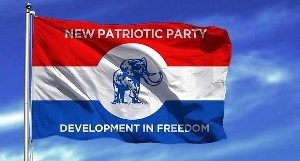- Home - News
- TWI News | TV
- Polls
- Year In Review
- News Archive
- Crime & Punishment
- Politics
- Regional
- Editorial
- Health
- Ghanaians Abroad
- Tabloid
- Africa
- Religion
- Election 2020
- Coronavirus
- News Videos | TV
- Photo Archives
- News Headlines
- Press Release
Business News of Friday, 7 October 2011
Source: Business Analyst
Red Flags Over Jubilee’s 120,000b/d Target
…As Ghana Gas Project Enters Borrowed Time
By J. Ato Kobbie, Managing Editor
Ghana’s Jubilee Field, which was expected to reach a plateau of 120,000 barrels per day, by August this year, may never reach that rate of production under the current phase of the field, The Business Analyst can reveal.
The field was projected to be producing at 120,000 b/d in the early second half of this year, as more of the 16 wells, comprising production, gas and water injectors, were brought on-stream.
Ordinarily, as and when wells were tied into the production system of the floating, production, storage and offloading (FPSO), they were expected to boost production, except where there was a conscious effort to store gas or some other product in such wells.
Hints of the target being missed had come from oil and gas analysts, including Dragan Trajkov, at Renaissance Capital Ltd in London, who in a telephone conversation with Bloomberg around mid-August said Tullow was likely to reduce full-year extraction guidance to below 90,000 barrels a day, the low end of a range announced on July 5 in London.
Royal Bank of Scotland Group Plc had, by August, already lowered its forecast for the Jubilee Field’s production to 88,000 barrels of oil equivalent a day from an earlier estimate of 94,000 barrels, Phil Corbett, an analyst at RBS, which is Tullow’s in-house broker, had told Bloomberg on August 18th. George Cazenove, a London-based spokesman at Tullow, declined to comment, saying the company will provide an update with its first-half results on August, 24th. On release of its first half results, the Group pegged its average for 2011 at 82-84,000 b/d with production exceeding 100,000 b/d by year-end. Tullow then projected Jubilee production to increase to 105,000b/d in October, with the plateau production of 120,000b/d still expected before year-end. Kosmos Energy, Technical Operator of the Jubilee Field, together with its brokers, also continue to project 120,000 barrels of oil per day by year end. The shortfall in Jubilee notwithstanding, Tullow Oil made a strong first half showing, powered by increased production from the Jubilee Field as well as higher crude oil prices.
The Group listed on the Ghana Stock Exchange (GSE), where its secondary listing reined in $73.2million.
With light crude demand outpacing supply and price forecasts of less than $90 per barrel breached by recent prices hovering above the $100 per barrel mark, the impact of the shortfall in production against projections would have little adverse impact on suppliers.
Even though the Jubilee Partners will not be excited about their inability to meet projections, for Ghana’s largest oil field, they have among them, 10 of Ghana’s 14 discoveries that are at various stages of development. The ten discoveries that the Jubilee Partners have are: Odum-1, Mahogany Deep, Teak-1, Teak-2, Banda-1, and Akasa-1, all in the Kosmos Energy operated West Cape Three Points (WCTP) block.
The rest are: Tweneboa-1, Tweneboa-2, Ntomme, and Enyenra (formerly Owo-1), all also within the Deep Water Tano block, which is operated by Tullow Oil. These can, however, leave them walking on tight ropes, if the current tight credit market continues to hold. The other four discoveries are Sankofa-1 and Gye Nyame-1, both within the Offshore Cape Three Points block (OCTP), operated by ENI; and the last two are Paradise -1 and Dzata-1, located in the Deepwater Tano/Cape Three Points, operated by Hess and Cape Three Points Deepwater block, operated by Vanco/Lukoil respectively.
Gas Infrastructure
Meanwhile, The Business Analyst has gathered that the Ghana National Gas Company (GNGC) is far advanced in clearing the hurdles towards awarding the contract for the construction of the shallow water extension of the gas pipeline from the FPSO Kwame Nkrumah to the Gas Processing plant site at Domunyili, near Bonyere in the Jomoro District of the Western Region.
The Chief Executive Officer (CEO) of GNGC, Dr. George Adjah-Sipa Yankey, in an interview with The Business Analyst a month ago, said his outfit was “determined to be meticulous and professional but with speed,” adding, “Continued flaring is something that we want to eliminate or avoid and we continue to remind ourselves and be guided by it”. Since the last week of April this year, gas is being re-injected into the Jubilee Field reservoir, to avoid wastage through continued flaring. The re-injection is expected to continue for a period not exceeding 18 – 24 months, after which period, re-injection might threaten the safety of the reservoir. In the event that the gas infrastructure is not in place at the end of the estimated safe period, the Jubilee operators would have to resort to flaring of the gas.
Dr. Yankey, had told The Business Analyst then that the front end engineering and designs (F.E.E.D.) for the shallow water portion of the gas pipeline would be completed before the end of November this year.
The Business Analyst has gathered however that the FEED would be completed ahead of schedule, in October.
A Ghanaian-based consortium of engineers, Worley Parson /Intec Sea/Atlantis, is handling the FEED, he revealed.
“We are working closely with the former agencies which started the project,” Dr. Yankey had disclosed, citing the Ghana National Petroleum Corporation (GNPC), Tema Oil Refinery (TOR), Bulk Oil Storage and Transportation (BOST), Volta River Authority (VRA) and the Energy Commission, when asked what has become of the work started by these agencies on the project. An evidence of that, he said, was in the fact that senior officers from these agencies have been seconded and are working closely with GNGC, adding that this collaboration will continue.
“We are taking off from where GNPC left off and it is our desire to work collaboratively in the national interest,” the GNGC boss stated. Dr. Yankey said GNGC has the primary responsibility to pipe gas from the Jubilee Field offshore to feed processing plants onshore, and transporting the processed gas to markets, which will initially be the Aboadze Thermal Plant site at Takoradi. The initial transmission pipelines to be constructed from the Domunyili gas processing site would be to Aboadze, and later Tarkwa and Abosso, when more gas is brought on-stream, the GNGC boss revealed.
The Aboadze Thermal Plant, which is the target market for the initial processed gas, requires 120million standard cubic feet (scf) of gas as fuel to generate electricity. He said the objective is to achieve cheaper power generating cost, adding that additionally, “Along the pipelines, we hope to attract investors to build power plants which will use gas as fuel to generate electricity,” The first phase of the project involves the laying of gas pipelines from FPSO Kwame Nkrumah MV 21 in the Jubilee Field to Bonyere, the construction of a gas processing plant and transportation of processed gas to feed the Aboadze Thermal Plant for cheaper electricity.
GNPC had already constructed a 14-kilometre stretch of the deepwater portion of the pipeline and the company says it would ensure expedited action to lay the remaining 36-kilometre stretch to the Domunyili gas processing site onshore at Bonyere. BOST had also undertaken surveys of the likely route of the gas pipeline and storage sites from Domunyili to Pumpuni, all in the Western Region. The GNGC is taking over from a transitional Project Implementation Unit (PIU), consisting of two representatives each from the various agencies and headed by Government Energy Policy Advisor, Nii Amarh Amarquaye.
Meanwhile, the Board of the GNGC has declared its commitment to work assiduously at meeting the country’s objective of fast-tracking the gas infrastructure development.
Giving the assurance at the inauguration of the Board in Accra last week, the Chairman of the Board, Dr. Kwesi Botchway, said failure is not in their horizon and they would go to all lengths to deliver on their mandate. Dr. Botchway, a former Minister for Finance and Economic Planning (MOFEP) was chairman of a National Gas Task Force that was set up last year by the President to recommend the way forward for the national gas infrastructure project. The task force submitted its report to the President in April this year.
Inaugurating the Board, the Minister of Energy, Dr. Joe Oteng-Adjei said in a country where gas for power generation was at its infant stages, it was important to first focus on domestic utilization, mainly for power, fertilizer production, methanol production and the petrochemical industry.
The other Board Members of the Board of Directors of GNGC are Dr. Yankey, Dr. Valerie Sawyerr, a Deputy Chief of Staff of the Office of the President, Mr. Thomas Manu, Director (Exploration & Production) of GNPC, and Mr. Eric Yankah, a former Deputy Chief Executive Officer of the Volta River Authority (VRA). The five-member Board has Mr. Agbesi Dzakpasu as Secretary.
Also present at the inauguration were directors at the Ministry of Energy and Deputy Minister in charge of Petroleum, Mr. Emmanuel Armah-Kofi Buah. j.atokobbie@yahoo.com










